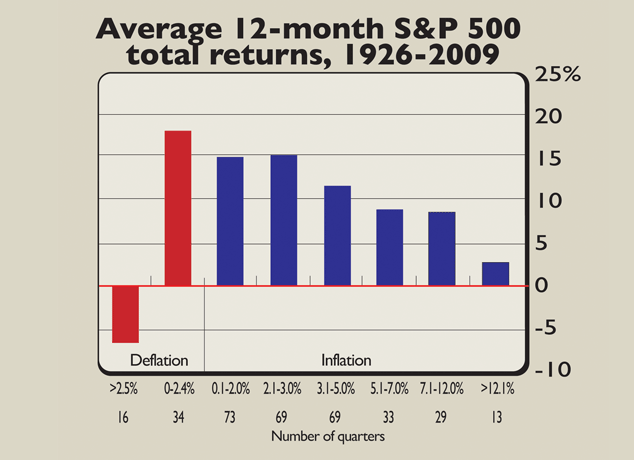
Last week we learned that the UK is on the verge of deflation for the first time in decades. Prices were flat over the 12 months to February – the lowest inflation reading since the current consumer price index (CPI) series began in the 1980s and probably the lowest since the 1960s. Lower energy prices mean that an outright fall in the CPI is likely when the figures for March are published this month.
For those of us who’ve only ever known a world of inflation, this may sound quite worrying. We tend to associate deflation with periods of economic trouble, such as the Great Depression, when stocks performed very poorly. But deflation isn’t automatically bad for markets – in fact, it can even be good news. It all depends how much prices are falling and why it’s happening.
Extremes are bad news
There are two ways in which inflation and deflation can affect stock returns. The first is the impact on company profits. The second is by changing what investors are prepared to pay for those profits. History tells us that both extremes of severe deflation and severe inflation are bad news for stocks, although for different reasons.
Severe deflation, as seen in the 1930s, creates plenty of problems. It’s generally associated with economic troubles, such as high unemployment, lower consumer spending and cuts in investment – in other words, a recipe for weak demand.
Companies come under pressure to lower prices in an effort to shore up sales, yet may have fixed costs that are not falling, such as long-term leases and the cost of servicing debt. As a result, margins get slashed and profits fall.
Many firms go out of business, creating a vicious circle of lower demand and further deflation. Against this backdrop, it’s no surprise that investors are fearful and prefer to keep their money in cash or government bonds. As a result, valuations collapse along with profits.
Conversely, severe inflation, as seen in the 1970s, sees firms struggling with rising input costs, such as raw materials and wages. It becomes difficult for them to pass these costs on in the form of price rises as quickly as they’d like, so once again margins get cut.
Unlike deflation, high inflation helps to erode fixed costs, such as their debt burden, so the cycle of company failures and falling demand doesn’t set in as it does during deflation.
But profit growth starts to lag behind inflation, while uncertainty about the economic outlook grows. So investors abandon stocks in favour of hard assets, such as precious metals, commodities or real estate, and valuations fall. Stockmarkets again make large losses, at least in real (inflation-adjusted) terms.
If inflation spills over into hyperinflation, stocks may start to perform relatively well. That’s because desperate savers, seeing the value of their cash and bonds eroded daily, plunge into the stockmarket.
We’ve seen this in economies from Weimar Germany to Venezuela. That said, hyperinflation is invariably accompanied by a collapsing currency, so simply getting money out of the country is usually a better decision in this kind of situation.
So if the extremes of deflation and inflation are not good for stocks, what kind of environment is? Unsurprisingly, the answer seems to be one with relatively steady changes in prices. The chart below shows the average 12-month return (including dividends) for the S&P 500 during different inflation environments.
As you can see, periods of low inflation and mild deflation have been associated with the strongest returns on stocks. Indeed, mild deflation (as low as -2.5% per year) saw the best average performance.
All else being equal, it’s not hard to see why mild deflation or low inflation create an exceptionally helpful environment. Companies will be able to pass modest price rises like these along fairly easily, ensuring that margins remain solid.
Meanwhile, solid profits and economic stability will make investors more confident and thus more willing to pay higher prices for stocks, meaning that valuations will expand.
A deflationary boom
This is especially likely to be true if the cause of deflation or low inflation is due to productivity gains. If companies can do more with less – for example, due to new manufacturing technology – they can afford to keep prices low, or even cut them. This has arguably been a major contributor to the corporate profits boom of the last two or three decades, as continuous innovation in technology has brought down costs.
At the same time, globalisation has held back wages, meaning that firms were under little pressure to share the benefits of this productivity with their workforce, leading to soaring profit margins.
Obviously, the inflation rate isn’t the only thing driving stocks, so our move into deflation doesn’t guarantee markets soar further. Other influences are less encouraging. Equities look expensive by historical standards.
Interest rates are set to rise later this year in the US, and possibly UK. A tighter labour market could finally put pressure on wages and hence on corporate margins. Nonetheless, it’s clear that deflation is not always the headwind that it’s often portrayed to be.